Published: November 2, 2023
Can an Indie author publish like a traditional publisher?
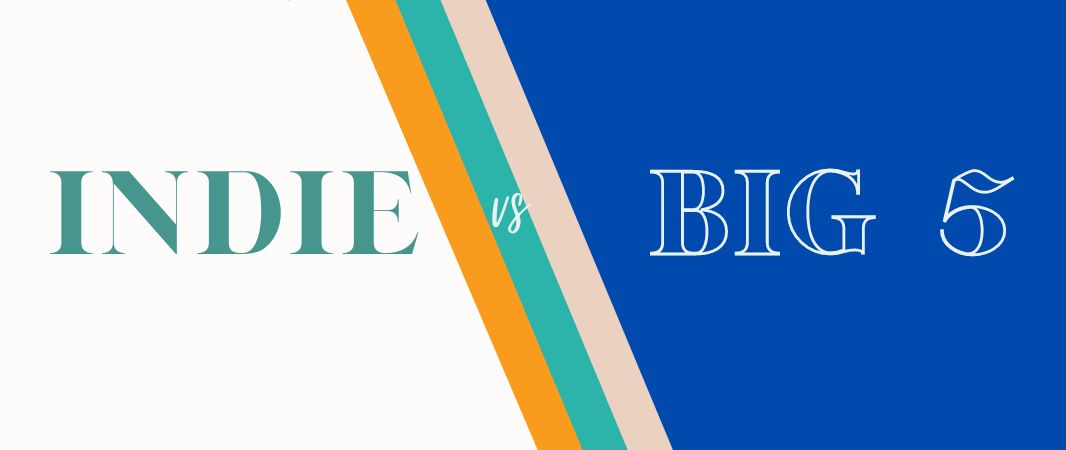
Indie or self-publishing has become a terrific avenue for writers who want to get a print book out into the world. Self-publishing authors can make beautiful, professional books that rival those produced through traditional publishing paths, and a very robust print-on-demand printing and distribution system allows millions of authors to distribute their books online and to bookstores every year.
For this reason, many writers are choosing this option. Self-publishing eliminates the daunting and lengthy process of looking for an agent, it allows you to have more control over the book production, and it lets you work on a shortened timeline.
But there’s a persistent rumor that self-publishing should be quick, easy, and inexpensive, which, if it’s done right, is just not the case.
Publishing is the step of transforming your writing into a book.
Publishing is the step of transforming your writing—whether it’s a story, instructional, informational, etc.— into a book. Unlike your Word document, a book is a salable product, the vehicle by which you are going to present your writing to the world.
When you choose to self-publish, you are taking on the task of creating your physical book and making it available for sale. There’s an art and a process to bookmaking, and if you want to have a successful book publishing experience, you need to pay attention to the details as a publisher would.
If a book is correctly produced, there should be no difference in the publishing process between traditional and independent publishing. It comes down to who is doing the tasks to convert your writing into a book. Any successful book should be edited, professionally designed, and published so it can be found and purchased. If you are self-publishing, you are responsible for all of these tasks since you are acting as the publisher.
Can you do it all for free? If by for free you mean by yourself, the answer is maybe. But most authors seek professional help and guidance for some, or all, of the bookmaking tasks. Copy editing, cover design, book layout, and book publishing are not common skills, and you can spend months or years mastering them—months or years you could spend writing instead.
Note: if you just want to get something out there, there are sites where you can upload a manuscript and create an e-book for almost free. Because this is such a quick and inexpensive option, the field is crowded, and it’s doubtful you will be able to find a large audience.
So the question is this: How do you, as an independent publisher, publish your book in the same way that traditional publishers do?
At Luminare Press, we’re in the business of helping authors transform their writing into books. I’m going to share the framework we use to publish books that are indistinguishable from books that come from a traditional publisher. If you can understand both what processes are necessary and how to find reliable resources, you’ll be way ahead in the publishing game.
The Publishing Framework
Once the book is written, there are three important components to publishing:
- polishing your writing,
- designing the book,
- and making it accessible to readers by publishing it.
This is how traditional publishers approach books, and as an independent publisher, you need to understand and pay attention to all three of these.
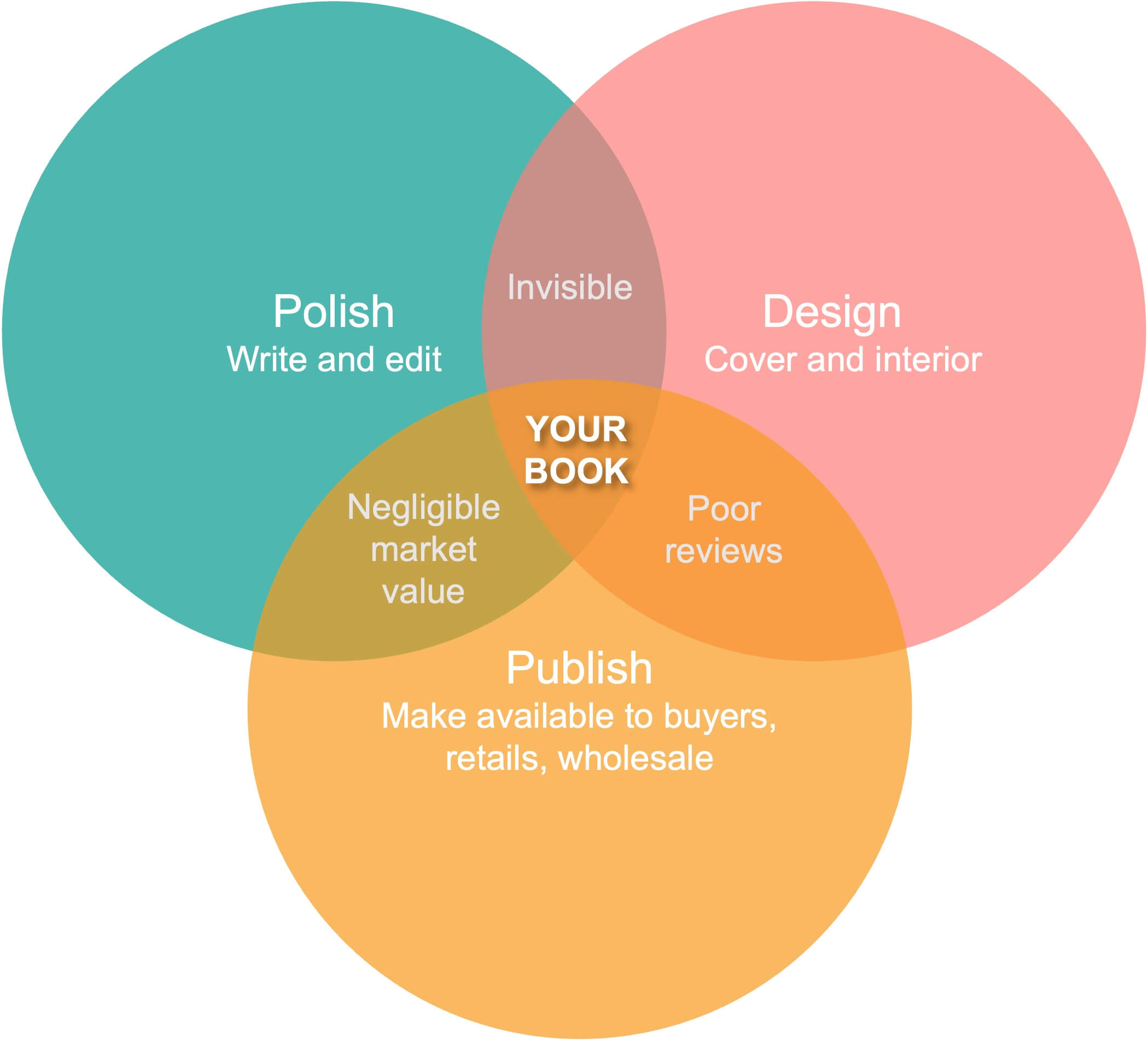
Neglecting any one of these elements will make your book considerably less salable.
- If you produce a well-edited, professionally designed book (Polish and Design) but readers can’t find your book (most likely through online retailers such as Amazon) they can’t buy your book.
- If your book is edited but isn’t laid out in a conventional format with an appealing cover, they are less likely to buy it even if you do set it up for sale correctly (Polish and Publish).
- And if your book is riddled with grammar errors or illogically constructed, no book professional will take it seriously, no matter how beautiful the cover, and readers will not review it favorably (Design and Publish).
But when all three of these components are given the attention they deserve, your book will come out of the starting gate ready to be purchased, read, and reviewed favorably. And for a writer, that is as positive a starting point as you can hope for.
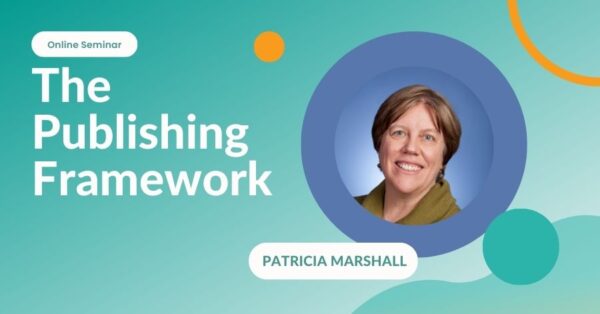
Let’s look at the framework components one at a time.
Polish
The more polished and professional your book is, the more likely it is to be well received by readers and people in the book industry. You absolutely do not want to go to the time and expense of producing a book that garners negative reviews for grammar or plot mistakes that could easily have been corrected.
A lot of writers work informally with writing groups, beta readers, or both as they are writing a manuscript. By the time they are ready to publish, the manuscript has gone through numerous drafts and rewrites, and the work is ready to present to the world. It’s a rare writer (like, unicorn rare) who writes and publishes a successful first draft. Revision and multiple drafts are a widely acknowledged part of the writing process, and most writers know that as painful as this process can be, it’s worth going through (See Ten Questions for Better Reader Feedback).
Your beta readers and writing group fellows will be paying attention to story, flow, structure, and character development, and though they may point out some grammar, spelling, and punctuation errors in the process, their reviews will not be a substitute for a copy edit.
A copy edit comes AFTER the polishing, rewriting, etc., and is the step where an editor pays attention to the minutia of the text—the misplaced comma, the mix-up of “their” and “there” that spell check will not catch.
Some writers use online tools for this process. Most text programs have spelling and grammar functions, and there are more extensive programs, such as Grammarly, that can help you spot errors. At minimum, you should put your finished manuscript through one of these checks. We have not found them 100 percent reliable, but they are better than nothing.
If you can afford it, hiring a professional copy editor—one who will both copy edit your manuscript and proofread your book after layout—is your best option. The title “editor” has no formal qualifications required, so you want to be sure the person you’re working with is legitimate. Engage someone with a background in copy editing who can provide you with references and samples of their work.
Agree on a style guide and ask them to create a style sheet with information specific to your book as they go. Most books use the Chicago Manual of Style as a reference. (If the editor is not familiar with this, or with creating a style sheet specific to the book, I would consider that a red flag.)
You can see this link How to find and hire an editor for more information.
Once your book is edited, it’s ready for the design phase.
Design
Creating a cover and interior layout for your book is possibly the most misunderstood part of bookmaking.
To print a book, whether it’s a multiple copy run printed using off-set printing or a print-on-demand book which is printed when it’s sold, you have to have two files: a cover file and an interior file. These are the files that your book is going to be printed from.
Each of those files has to be designed to conform to the standards of the industry and to meet the printer’s specifications. Understanding what goes into making the cover and interior and how to go about getting print-ready files is key to successful publishing.
A cover consists of the front, the back, and the spine
First, let’s talk about the cover. During preliminary book discussions, I often here authors say something like this: “I have my cover already, it’s a piece of art that my friend drew.” I love hearing this—it’s extremely helpful to have a starting point for a cover design. But it is not the cover.
And even an image with a title and author name over it is not the complete cover. A cover consists of the front, which is usually an image and text, but also the back and the spine. A cover file is one long design that looks like this.
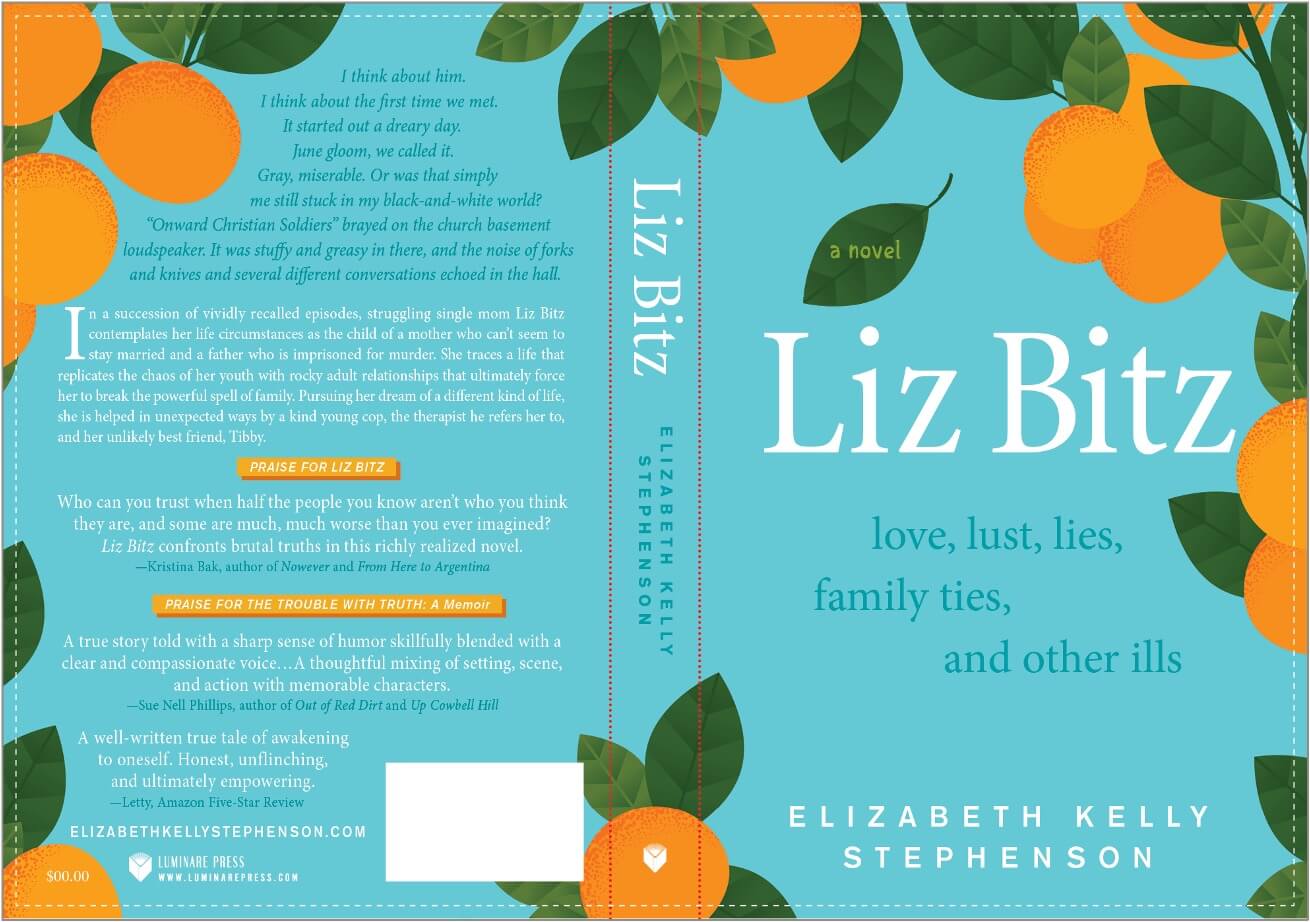
You can see that there are a lot of things going on in this example. The obvious elements, and the ones most people think of as the cover, are the title, author name, and image in the front. But the cover file also has the spine and the back. It’s printed as one sheet, which is then wrapped around the interior pages.
The front text is usually repeated on the spine, which also has the publisher logo.
The back cover can contain the book description, blurbs, author photo and bio, bar code, retail price, and publisher imprint.
All of these surfaces—the front, the back, and the spine—need to work together. That’s the job of a designer, to create a cover in which all the parts are cohesive. Font and image selection, readability, and general appeal are all part of that. It’s also the designer’s job to be sure that the cover meets the specification of the printer. The spine width must be adjusted to meet the final page count of the printed book. The bleed, the area of the image that extends beyond the trim line, must be included.
The interior layout is equally important. The care that goes into creating book pages is the heart of the publishing process. It is the work that is done for the reader and pages should be designed with the reader in mind. That, of course, means readability, but also suggests an appealing layout and appropriate guides for the reader. Things like the table of contents, section and chapter titles, and headers and footers on each page all help anchor the reader in the text. You want your story to be enhanced by an exceptional layout. If you are writing non-fiction, you want your words and emphasis to be made clear by consistent use of images, subheads, maybe footnotes, bibliographies, and more.
It’s essential that the book have a readable font (I know it seems obvious, but I’ve seen books printed using small, crowded text, or almost worse, Comic Sans font). The book should be paginated correctly, with all front and back matter in place. The text should be even on both sides (no ragged right edges) and the gutter, or spine side, margin should be wider to accommodate the binding. Blank pages shouldn’t have headers or footers and table of contents should be set up correctly.
We often show or see pages in spreads (a two-page view) but when the file is finished, it will be single pages that will be printed front and back for binding.
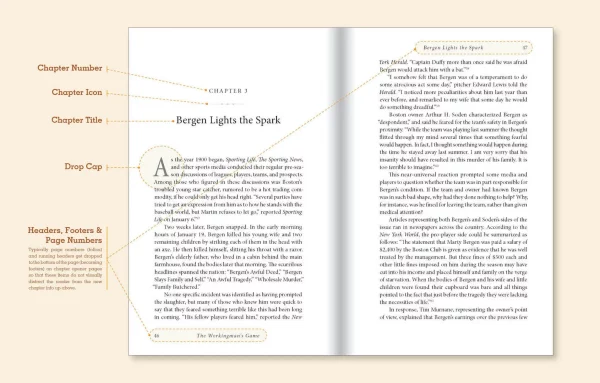
Creating these two files is an excellent place to hire experts. It is probably the most time consuming part of the process, aside from writing and editing, and potentially costly, but having an interior that is well laid out presents your words in the best light and makes your book a pleasure to read.
Need help designing your book?
Check our design services or our most convenient publishing packages
Publish
The third component to successful publishing is the step that most writers think of when they think of “free.” It costs nothing to list your book on Amazon and make it available for sale, and if you want to distribute through Ingram Spark, the cost is nominal ($12 a year at this writing).
You must set your book up correctly
That does not mean publishing is pushing a button. You must set your book up correctly: price it reasonably, set up sales discounts that are acceptable to retailers in the industry, and make sure that your book will be available where readers expect to find it.
To do that, we recommend using KDP to distribute to Amazon and IngramSpark to distribute to everyone else. This allows you to take advantage of Amazon’s retail system, while giving you more control over sales distributed through Ingram Content Group. (KDP allows you to distribute through Ingram but distributing your book that way adds an unnecessary layer of cost that won’t serve you well.)
This is the stage at which you need to procure an ISBN, and how you do that will affect how your book will be perceived. KDP can provide a free ISBN, but it limits your distribution. You can buy your own ISBN and create your own publishing company, but it will be obvious to most serious book buyers that you are managing your own book production. Some companies (like Luminare Press) can provide an ISBN as part of a publishing package.
You will also need to understand how to price your retail book. Both KDP and Ingram have printing and royalty calculators that will help you determine what the retail price should be, and what effect it will have on your royalty, but in general, you want the price to be in line with other books of its kind. A 300-page paperback usually retails between $14.95–$19.95. Price it at $24.95 and you risk missing a significant group of readers.
Likewise, you need to set your sales discount, which is the discount given to booksellers. KDP distributes directly to retail, and you don’t have a discount choice, but if you are using Ingram, you want to set the discount at 55 percent if you want bookstores and online retailers to be interested. This gives them the pricing they expect from traditional publishers. Setting a lower discount (you can go as low as 40 percent) will give you a higher royalty but will disincentivize retail book buyers. Brick-and-mortar stores will not be inclined to stock or even special order your book, and online retailers (other than Amazon) may show your book as out of stock or with a long delay.
As with every step of publishing, you want to do your research and not make any mistakes that you can’t undo. Both KDP and Ingram offer support and help, but it’s essential that you understand what you need to do to make your book available to the widest number of readers.
Need detailed instructions on how to publish your book?
Check out our online class NOW ON SALE
Conclusion
Paying attention to editing your writing, making a beautiful and readable book, and setting up your POD publishing correctly will go a long way toward your book’s success.
You may have noticed that I haven’t talked specifically about marketing your book here. Most authors want to talk about marketing first, but everything I’ve told you IS the first step of marketing: write a good book, produce it so that it’s appealing, and make sure that your readers can find it. While you’re doing that, of course, you can be building your email list, creating a marketing plan, and more, but without a good book, you’ll be wasting time, and possibly money, trying to sell it.
For now, focus on how to get the best book out there before you tackle how to sell it. The tasks in this framework are largely one-and-done, while marketing is an ongoing feature of an author’s life. You will be addressing it, but without the solid foundation that I talk about here, your marketing efforts will be wasted.
